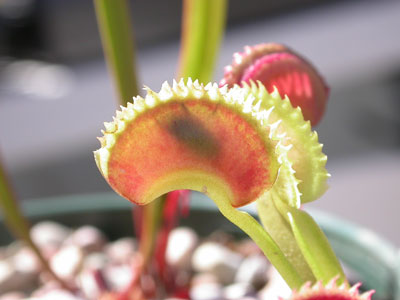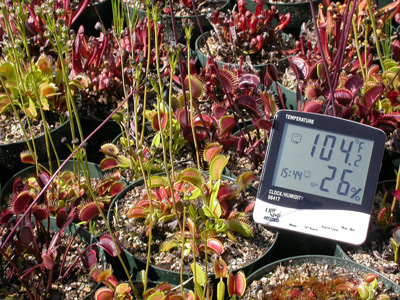Venus Flytrap Care
Get the straight facts from guys who grow and propagate thousands of carnivorous plants every year.

The Venus flytrap, Dionaea muscipula, with its mouth-like leaves, is the most iconic of all carnivorous plants, and one of the most recognizable plants in the world. Thanks to its popularity in cultivation, there are many different varieties of this single species, coming in a fantastic array of sizes, shapes, and colors.



Range
The Venus flytrap is a cold-hardy perennial native to the 90-mile (145-km) radius around Wilmington, North Carolina, growing in the sunny, coastal wetland savanna. That region gets very hot in summer and can see snow in winter. Like other perennials native to North Carolina, such as roses and lilies, Venus flytraps go dormant in winter and resume growth in spring.
Where to Grow
As a cold-hardy perennial, the Venus flytrap grows best outdoors as a container or potted plant. You may also grow it in a pond or fountain, but avoid submerging the plant. The water level should remain below halfway up the pot. Because of its specific soil requirements, avoid planting it directly in the ground.
Sunlight
Your flytrap requires full sun (6 or more hours of unobstructed, direct sunlight) for vigorous growth during the growing season. If full sun is not possible, your plant can maintain adequate growth with partial sun (4-6 hours of direct sunlight). However, it won't be as robust, healthy, and colorful as one grown in full sun. The rule of thumb is to grow it in the same sunlight as a tomato plant. When in doubt, give more sun.
Heat Tolerance
Your flytrap will tolerate the summer heat very well. Remember, it is native to the coastal plains of North Carolina where sweltering summers with temperatures above 90°F (32°C) can occur. It's even possible to grow these a flytrap in the desert Southwest.

Water
Your flytrap requires water low in minerals. If your tap water is relatively pure (less than 50 parts per million in dissolved minerals), you can safely water your flytrap with it. Otherwise, use bottled distilled water. You can also use rainwater, deionized water, and water filtered through a reverse osmosis unit.
Keep the soil wet at all times, even during winter dormancy. You can do this by setting the plant in a shallow tray of standing water. An inch or two of water is sufficient. Just make sure the water level remains below halfway up the pot.
Soil
Use equal parts sphagnum peat moss and perlite. Never use potting soil, compost, or fertilizer; they will kill your plants.
Winter Care
Your flytrap will stop growing in early fall, and some upright traps will turn black. These are signs that your plant will soon be dormant, a similar process when a rose bush goes dormant and drops its leaves in fall. While dormant, your flytrap can withstand episodes of overnight frosts down to 20°F. If daytime temperatures are projected to rise above freezing, you don't need to protect it from these overnight frosts. However, protection is required during prolonged freezes to prevent dehydration or freeze drying, regardless of USDA zone. Covering your plant with a tarp or black plastic sheet will be sufficient if the freeze is expected to last for a week or less, which is typical for USDA zones 7 and 8. Otherwise, mulch may be required if you live in a region where freezing temperature is a way of life, such as in USDA zones 6 and colder.
Need more information about winter care? Watch the
Volume 1 playlist
and monthly videos.
Our digital download,
The Ultimate Carnivorous Plant Guide for Beginners,
is also a fantastic resource if you are new to growing plants. We share how various elements – sunlight, water, soil, and humidity – affect plant growth and what to pay attention to during winter dormancy. Visit the website to access these resources.

THE ULTIMATE CARNIVOROUS PLANT GUIDE FOR BEGINNERS
In this downloadable ebook, Jacob Farin, co-owner of Sarracenia Northwest, will show you how to think like a professional carnivorous plant grower and keep your first carnivorous plant alive and healthy. You will learn:
- how sunlight and water affect plant growth.
- what type of soil and pots to use.
- if you really need to shelter your plants from snow and ice.
- how to troubleshoot common plant problems.
If you are new to carnivorous plants or have struggled to keep them alive, this ebook is for you. Download your copy today!
